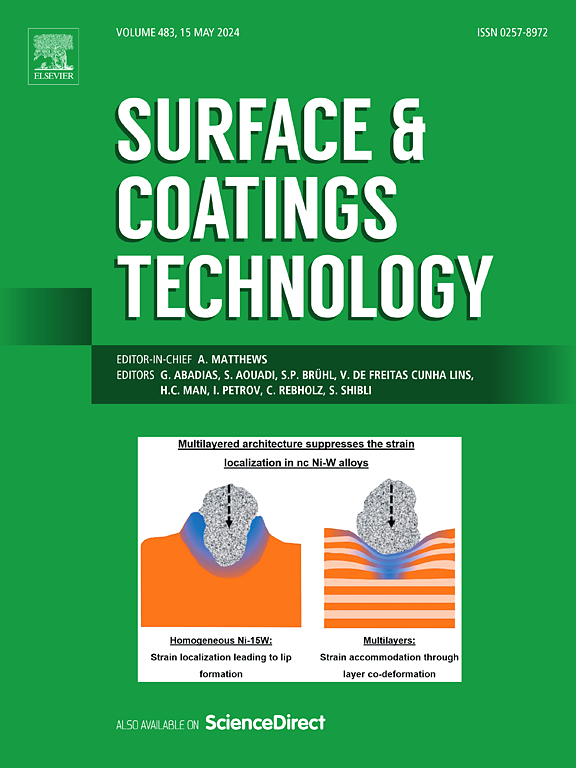真空等离子体甲烷裂解制氢方法
IF 5.3
2区 材料科学
Q1 MATERIALS SCIENCE, COATINGS & FILMS
引用次数: 0
摘要
甲烷裂解在不直接产生二氧化碳的情况下可以产生氢气和碳基材料,因此具有很高的吸引力。然而,大多数甲烷重整过程需要高温(超过600°C),而催化剂材料是集成的。为了解决这一挑战,在本工作中,研究了使用低压射频等离子体系统裂解ch4,以分析产生的分子氢和碳基产物。采用质谱法(MS)和发射光谱法(OES)鉴定了关键物质,如氢(H2)、CH自由基和C2烃。此外,x射线光电子能谱(XPS)用于检查射频等离子体反应器内的碳沉积。此外,能谱分析显示出明显的Hα、Hβ、CH自由基和C2天鹅带发射峰,四极杆质谱分析证实了氢分子的产生。结果表明,在等离子体沉积系统中,有效的甲烷解离发生在固体碳形成的同时。此外,利用XPS技术鉴定了沉积的碳为氢化非晶碳(a-C: H),含有sp2和sp3杂化碳原子。此外,更高的射频输入功率显著提高了等离子体密度、电子温度和ch4转换效率,在达到饱和状态之前,其性能在300 W时达到峰值。这些饱和效应是由于空间电荷现象和能量分布向其他过程,如解离和电离。本文章由计算机程序翻译,如有差异,请以英文原文为准。
Method for hydrogen production by methane cracking using vacuum plasma
Methane cracking is highly attractive as it can produce hydrogen gas and carbon-based materials without directly generating carbon dioxide. However, most methane reforming processes require high temperatures (over 600 °C) while catalyst materials are integrated. To address this challenge, in this work, the cracking using a low-pressure RF plasma system is studied to analyze the produced molecular hydrogen and carbon-based products. Mass Spectrometry (MS) and Optical Emission Spectroscopy (OES) were used to identify the key species such as hydrogen (), CH radicals, and hydrocarbons. Additionally, X-Ray Photoelectron Spectroscopy (XPS) is used to examine carbon deposits within the RF plasma reactor. Moreover, the OES spectra revealed distinct emission peaks for , , CH radicals, and Swan bands, while quadrupole mass spectroscopy confirmed the production of hydrogen molecules. The results obtained show that the effective methane dissociation occurs alongside solid carbon formation within the plasma deposition system. Besides, using the XPS technique, the deposited carbon was identified as hydrogenated amorphous carbon (a-C: H), containing both sp2 and sp3 hybridized carbon atoms. Furthermore, it was observed that higher RF input power significantly enhances plasma density, electron temperature, and conversion efficiency, with a peak performance at 300 W before reaching a saturation situation. These saturation effects are due to the space charge phenomena and energy distribution towards other processes such as dissociation and ionization.
求助全文
通过发布文献求助,成功后即可免费获取论文全文。
去求助
来源期刊

Surface & Coatings Technology
工程技术-材料科学:膜
CiteScore
10.00
自引率
11.10%
发文量
921
审稿时长
19 days
期刊介绍:
Surface and Coatings Technology is an international archival journal publishing scientific papers on significant developments in surface and interface engineering to modify and improve the surface properties of materials for protection in demanding contact conditions or aggressive environments, or for enhanced functional performance. Contributions range from original scientific articles concerned with fundamental and applied aspects of research or direct applications of metallic, inorganic, organic and composite coatings, to invited reviews of current technology in specific areas. Papers submitted to this journal are expected to be in line with the following aspects in processes, and properties/performance:
A. Processes: Physical and chemical vapour deposition techniques, thermal and plasma spraying, surface modification by directed energy techniques such as ion, electron and laser beams, thermo-chemical treatment, wet chemical and electrochemical processes such as plating, sol-gel coating, anodization, plasma electrolytic oxidation, etc., but excluding painting.
B. Properties/performance: friction performance, wear resistance (e.g., abrasion, erosion, fretting, etc), corrosion and oxidation resistance, thermal protection, diffusion resistance, hydrophilicity/hydrophobicity, and properties relevant to smart materials behaviour and enhanced multifunctional performance for environmental, energy and medical applications, but excluding device aspects.
 求助内容:
求助内容: 应助结果提醒方式:
应助结果提醒方式:


